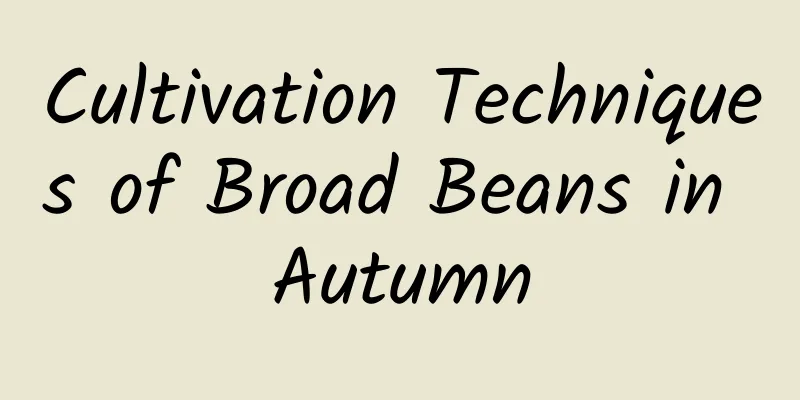Cultivation Techniques of Broad Beans in Autumn

|
Today I will tell you how to grow broad beans in autumn and the cultivation techniques of broad beans in autumn: (1) Variety selectionThe requirements for late autumn broad bean varieties are: strong cold resistance, good heat resistance, wide adaptability, intermediate or short photoperiod requirements, high fruiting rate, relatively concentrated pods, and can be put on the market in early to mid-April. Currently, large and small broad beans, local broad beans and other varieties can be selected. (2) Land preparationLand preparation requirements for planting late autumn broad beans: Before land preparation, the residues from the previous crop must be thoroughly removed and taken out of the field for disposal to reduce the base number of pest and disease sources. (3) Sowing seeds at the right timeThe sowing time of broad beans in autumn is after the rice harvest, which can not only ensure that the broad beans in autumn avoid adverse factors as much as possible, but also make full use of the limited growing season for growth and development, and it is very easy to achieve strong seedlings overwintering, laying a good foundation for a bumper harvest next year. Timely sowing can lay a good foundation for high yield. When planting broad beans in autumn, sowing should not be too deep or too shallow. Too deep or too shallow will cause difficulties in germination. If sowing is too shallow, the seeds will emerge with the seed coat when they emerge, and the soil is shallow, which is not conducive to the growth of seedlings; sowing too deep will cause the seeds to emerge slowly or difficultly, making the emergence of the entire field uneven, which is not conducive to field management. (4) Check and replenish seedlingsTwo weeks after sowing, check the field frequently and replant any missing seedlings in time to achieve 1 seedling per hole. (5) Reasonable topdressingWhen broad beans enter the peak period of flowering and podding, 5 to 8 kg of urea can be applied in the holes, 1 billion/g of Baobao microbial soil inoculant can be applied, 30 to 40 g of water can be poured on the roots, and 50 to 60 kg of 0.2% to 0.3% potassium dihydrogen phosphate can be applied per mu to ensure the broad beans to set podding. (6) Intertillage and weedingAfter autumn broad beans are sown, the temperature is still high, which is conducive to the occurrence of diseases, insects and weeds. In the seedling stage, because the seedlings are small and weak in growth, and weeds grow fast, it is necessary to carry out intertillage and weeding in time, generally 2 to 3 times. The first intertillage should be shallow, close to the roots of the plants, and slightly deeper between holes and rows; the second intertillage is slightly deeper, and the third intertillage is carried out before closing the rows. There will be no more intertillage in the future, but the intertillage should not damage the root system and leaves. The grass at the roots of broad beans should be pulled out by hand to avoid damaging the seedlings. (7) Ditch cleaning and drainageWhen broad beans are sown in autumn, waterlogging often occurs due to the wind and rain in autumn, so the ditches should be cleared and drained before the rain to dry the fields after the rain stops. In drought years, when the soil moisture is insufficient, water can be irrigated to moisten the surface of the ridges and then drain the water to keep the soil moist at all times, which is conducive to the growth and development of broad beans. (8) Pruning and pinchingPruning and pinching can not only reduce nutrient waste, return nutrients, and meet the needs of pod growth, but also improve yield and quality. Broad beans have the strongest branching among beans. The number of flowers and pods on the main stem of plants sown in autumn is less than the number of pods on the 1-2 branches at the base, and the pod setting rate is also low. Therefore, removing the main stem and a small number of flower pods can improve the nutritional status of the body, increase the number of branches and flowers, delay the flowering period, and increase the fruit setting rate. The appearance of the recurrent leaf of 6-7 leaflets (at about the 16th node) is a sign that sterile flowers are beginning to appear. Pinch off the top of the stem about 3 cm long at the 16th node. Pinching should be done on a sunny day to prevent the wound from not healing and causing rot. (9) HarvestingBroad beans are mainly harvested for tender beans and seeds, so they should be harvested in time. The harvested tender pods have good edible quality and can also promote other pollen on the plant to continue pollinating. The young tender pods can also get sufficient nutrients and develop quickly, increase their flowering and pod-setting rate, and extend the tender pod harvesting period to increase yield. |
<<: Artificial cultivation techniques of broad beans
Recommend
Ingredients and methods of mushroom and loofah soup
The raw materials of straw mushroom and loofah so...
The efficacy, function and medicinal value of snakeberry
Snakeberry is a fruit and also a Chinese medicina...
The efficacy and function of cantaloupe stem
Everyone must have eaten cantaloupe, but do you k...
Nutritional value and edible effects of sweet potatoes
The nutritional value of potatoes is very good. L...
How to make delicious cold cowpea salad? Home-cooked recipes for cold cowpea salad
Cold cowpeas are also very delicious, especially ...
How to make Hawthorn pain-relieving porridge
Hawthorn pain-relieving porridge is very effectiv...
Cultivation methods and precautions of Baolian Denghua
The leaves of the cardinal lantern are green, the...
How to eat ginkgo nuts and the benefits of eating ginkgo nuts
What else do you not know about the way to eat gi...
The efficacy of pig lung porridge
Pig lung porridge is very helpful for cough. Pleas...
How to preserve fresh daylily
Daylily is the fresh flower buds of an annual her...
How to make hawthorn jam How to make hawthorn jam
Hawthorn jam tastes sweet and sour and can be eat...
Ingredients and steps for making baby shrimp porridge
Babies are in a critical period of growth and dev...
The efficacy and nutritional value of sea cucumber
Sea cucumber, also known as sea mouse, wood meat,...
Nutritional value and cooking methods of horse meat
As people's living standards improve, meat in...
Can pregnant women eat figs? What are the benefits of figs for pregnant women?
Figs look similar to pomegranates. They are named...









